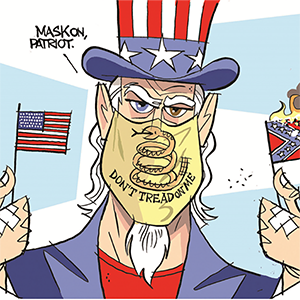Why it's impossible to make a car without China, regardless of tariffs
Published in Automotive News
WASHINGTON — Even as the Trump and Biden administrations have taken and maintained aggressive stances on reducing China's role in major U.S. manufacturing sectors, auto industry veterans say it remains impossible to build cars and trucks without help from the Far East.
That will likely stay true even if Republican President-elect Donald Trump levies the sweeping tariff increases on China and others he has threatened ahead of a January return to the White House.
"The industry has definitely been committed to building resilience," said Ana Meuwissen, a vice president for government affairs at the Motor and Equipment Manufacturers Association, the trade group representing U.S. vehicle parts suppliers. "But we can't fight the fact that some of these very unique materials and inputs are only available from certain parts of the world."
That fact leaves vehicle suppliers — which MEMA says is the largest manufacturing sector in the United States — in a difficult but not entirely new position. Companies that make engines, transmissions and more have six-year-old playbooks on how to navigate Trump's inclination toward tariffs. But the already-strained businesses could be pushed further if the GOP leader elevates trade barriers to new heights in a bid to stem China's undeniable automotive emergence.
The trade group, during Trump's first term, was clear in its past opposition to tariffs on Chinese manufactured goods that reached up to 25%.
"(I)mposing tariffs on motor vehicle parts could simply hurt consumers who need access to affordable motor vehicle parts — not only those buying new cars or companies buying new fleets of trucks, but those Americans repairing and maintaining the millions of vehicles that are currently on the roads today," past MEMA president and CEO Steve Handschuh wrote in 2018.
"We strongly recommend that President Trump not include motor vehicle parts in his new tariff policy," added Handschuh, who died in 2022. "Tariffs raise alarm bells and could send us backwards."
Since the tariffs came into effect, business conditions for auto parts suppliers have worsened. "Average supplier EBIT (earnings before interest and taxes) before COVID was about 8.5%. It's closer to 5% today," said Collin Shaw, MEMA's president for original equipment manufacturers.
Shaw did not blame tariffs for the falling profits and tried to downplay current worries over Trump's threats to further add blanket, 60% duties on Chinese goods — and perhaps another 10% on top of that.
"Whatever happens with tariffs, I think the market will deal with it," he said in a video interview, noting that suppliers are more focused on automation, uncertainty in the market for electric vehicles, and developments in artificial intelligence.
That market response, trade data show, has been to bring in more automotive parts from Mexico. The United States' southern neighbor — not China — is its biggest trade partner and largest foreign supplier of automotive parts.
Still, China's role up and down the auto parts supply chain has grown significantly over the past two decades, both at the highest levels and deep within the industry's complex global trade network.
China's growing role
China's expanded role on the world automotive stage was a clear, stated objective of national leaders, according to the nonpartisan U.S. International Trade Commission. The Chinese government began setting comprehensive economic plans for its domestic auto industry and automotive parts suppliers 30 years ago.
The first edition of that plan — the 1994 Policy on Development of the Automotive Industry — included broad goals for engines and electronics before getting more detailed over time, ITC analyst David Coffin wrote in a 2019 working paper.
A plan 10 years later focused on alternative energy and fuels, and in 2012 China set forth a plan specifically encouraging advancements in electric vehicle batteries and other high-tech parts, like supercapacitors. Those plans have proven to be successful.
About $558 million worth of automotive parts from China came to the United States in 1994, according to data from the U.S. Census Bureau. That represented approximately 1.2% of all U.S. auto part imports.
Both numbers have soared since then. Nearly $18 billion worth of automotive parts from China came to the United States in 2023, good for about 9.2% of all U.S. auto part imports.
China's biggest role — by total dollar value — is in "Other Parts Manufacturing." That broad category includes items like wheel rims, windshield wipers, air bags and filters.
Parsing similar data in 2019, Coffin of the Trade Commission wrote that this "seems to indicate that the Chinese automotive parts industry has been successful in supplying a range of components." Beyond that broad grouping, China's role shows up in more specific parts of the auto supply industry.
The country, famously, has become the dominant global producer of electric vehicle batteries. The United States has tried to catch up through sizable investments from the Biden administration into domestic production capacity, but it will take years for new facilities to come online.
In 2023, North America was able to meet about 63% of its own EV battery needs, according to an analysis by the International Energy Agency. China met 17% of that need, though that figure understates continued U.S. dependence on China for raw and processed minerals used in domestic battery production.
Reliance on China also shows up in the supply chain for aftermarket parts used by mechanics. In 2021, for example, the United States manufactured about $9.2 billion worth of vehicle brake systems. Imports from China for that category — mostly replacement brake rotors — were valued at about $1.5 billion, and $4.4 billion came from the rest of the world.
Altogether, that means China accounted for more a tenth of the U.S. auto industry's brake systems manufacturing in 2021.
The United States, notably, continues to manufacture more automotive parts — at least by dollar value — than it brings in. The value of U.S. motor vehicle parts manufacturing in 2021 was about $276 billion compared to $139 billion in imports from all countries, according to a Detroit News analysis of the most recent Census Bureau data.
Those figures, however, leave out important details about economic activity at lower levels of the supply chain.
Parts of parts
China's role in U.S. automotive parts has grown in ways not easily visible through high-level U.S. import and manufacturing data.
"Let's assume a gearbox. There's a four-tier system," said Tu Le, managing director of Sino Auto Insights, an innovation and management consulting firm with offices in Detroit and China. He previously worked in sourcing for General Motors Co. and Lear Corp., a major automotive parts supplier.
Le described gearboxes — also known as transmissions — as "bad shippers." Completed ones are too heavy and cumbersome for affordable shipping around the world, so companies instead ship their component parts and assemble the final systems near auto assembly plants. But there are steps even before that.
"The raw material gets turned into a semi-raw material of this component. And then this component gets built into this module. And then this module gets shipped to the factory that builds the gearbox," Le explained. "It's three or four levels deep."
Items that enter the United States through Canada or Mexico — and are appraised by U.S. Customs and Border Protection as goods from those two countries — are increasingly made with the help of lower-value subcomponents from China.
About 4% of Mexican imports of automotive parts, accessories and subcomponents came from China in 2012, according to data from the United Nations' Comtrade database. Those imports represented about $883 million. China's share has since tripled to roughly 12%, or $4 billion, in 2023.
That expansion in Mexico is consistent with general trends in the U.S. economy since Trump imposed 25% tariffs on many Chinese products during his first term.
"(T)he reshaping of U.S. imports away from China may not have reduced dependence on China as much as import numbers suggest," University of California San Diego economist Caroline Freund wrote in a recent journal article.
She and her co-authors explained that was because countries like Mexico "that were more deeply engaged in Chinese supply chains experienced the most rapid export growth to the U.S."
In other words, Freund's findings indicate that global businesses have adapted to Trump's first-term tariffs by adjusting their supply chains to suppress — but not always reduce — China's role.
If (new) tariffs happen
Looking ahead to potential new tariffs or other trade barriers, Le emphasized that "this is the complexity we have to deal with." If Trump targets every level of the automotive supply chain, then the difficulty for parts producers to reconfigure their business would be "orders of magnitude larger."
"Parts are transformed and worked on all over the globe," said Shaw, of MEMA. "It's very hard to separate some of those global environments. We have teams that are working cross-functionally across different regions. It's not only China."
Disrupting those linkages to avoid tariffs could be costly, in money and time. "We need something that we know is validated — that the industry has been able to test — to establish those relationships, to then source appropriately for our products," said Meuwissen, of MEMA.
Increased duties on Chinese products specifically would likely lead industry leaders to add second manufacturing locations for the product, said Warren Browne, an auto supplier consultant and former GM executive who worked at the carmaker for 40 years.
“Let's double tool it, put it into Mexico, and therefore we can balance the political dynamics by determining how much we want to make in China and how much we want to make in Mexico,” Brown said. “They're probably doing that as we speak. That mitigates the risk.”
Some businesses could also opt to source their products from new countries.
“If it's China only, manufacturers will go through a natural process of determining whether first double tooling makes sense or secondly whether resourcing to South Korea or Mexico makes sense,” Browne said. “If they had to resource, it would take six months if they have never talked to a supplier. If they had double tooling, they could get that double tooling going and pull that trigger whenever they wanted to.”
But sourcing from another country and double tooling both come with potential consequences, including cost impacts and unhappy China-based suppliers.
“In the case of duties on everybody, it just becomes monumentally more complex including the increase of domestic parts cost,” Browne said. “If you put the duties on everybody, costs just go up, both for domestic and for imported.”
"We still do need materials from China," Meuwissen acknowledged, adding that the most crucial ones include semiconductors, critical minerals, batteries and magnets that the Biden administration has targeted through its own set of new tariffs announced in May.
She continued: "These are things that currently the industry simply cannot source at the volume that it needs from other locations."
©2024 www.detroitnews.com. Visit at detroitnews.com. Distributed by Tribune Content Agency, LLC.








Comments